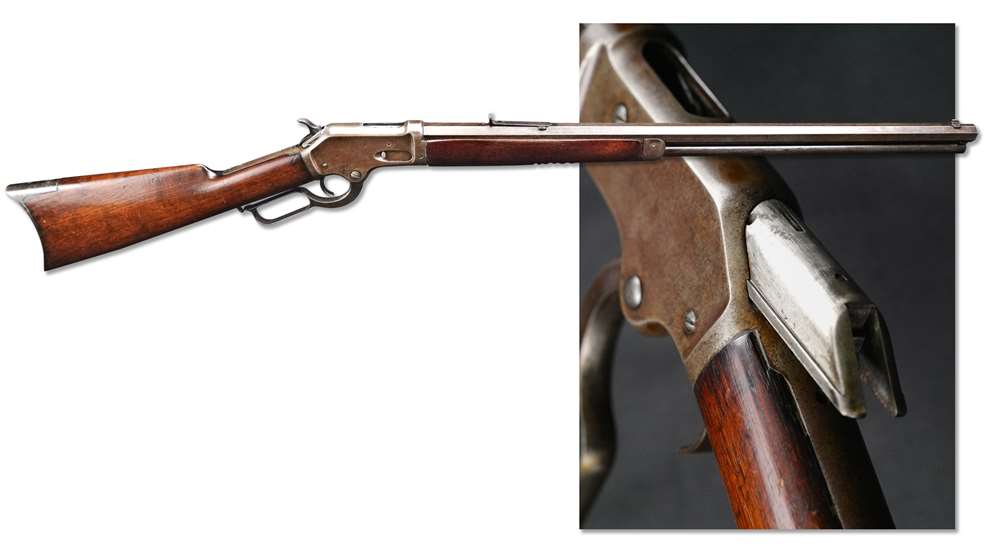
Gun: Colt-Burgess Rifle (a.k.a. Colt New Magazine Rifle; 1883 Burgess)
Manufacturer: Colt’s Mfg. Co.
Chambering: .44-40 Win.
Manufactured: 1884
Condition: NRA Very Good (Antique Gun Standards)
Value: $7,500
There was a time when firearm manufacturers were primarily known for producing only one specific type of gun. In fact, their fame, reputations and, often, their fortunes hinged upon it. For example, Smith & Wesson had always been celebrated for its revolvers and, by the late 19th century, Marlin’s name was synonymous with lever-action rifles.
Today, of course, the gates to the competitive field have been thrown wide open, with Smith & Wesson producing a variety of lever-actions and AR-style rifles in addition to revolvers and semi-automatic pistols. Marlin lever guns are now being made by Ruger, a company that built its early success on semi-automatic handguns and single-action revolvers, and which has since branched off into double-action revolvers and semi-automatic, bolt-action and AR-style rifles as well.
But 145 years ago, Colt and Winchester were two of the most celebrated names in American firearms, with Winchester being renowned for its 1866, 1873 and 1876 lever-action rifles, while Colt had achieved near-legendary status with its Single Action Army and its newly released Model 1877 and 1878 double-action revolvers.
This was still the era of Western expansion, however, and with the American frontier far from settled, the demand for firearms was persistent. It was accelerated by the expiration of Rollin White’s patent in 1870, which permitted Colt to start producing cap-and-ball conversions and the 1871-72 Open Top that ultimately led to the Single Action Army. Others, such as Remington and Merwin & Hulbert, would shortly enter the fray, potentially cutting into Colt’s market. That may have been what prompted the company to consider expanding into Winchester’s lever-action domain. To achieve that objective, Colt hired Andrew Burgess, an accomplished firearm inventor who was instrumental in perfecting Marlin’s Model 1881 (the first lever-action capable of chambering the popular and powerful .45-70 Gov’t cartridge), specifically to design a lever-action that would compete with Winchester’s famous Model 1873.
Along with patents Colt purchased from inventor R.L. Brewer, Burgess designed what became the Colt-Burgess Rifle. Like the gun it was poised to challenge, the Colt-Burgess was only chambered in .44-40 Win. and was available as a 25½" round- or octagon-barreled rifle, half-octagon sporting rifle and a 20" saddle ring carbine.
Externally, the Burgess slightly resembled the Winchester ’73, but with notable exceptions. It lacked the sliding dustcover and lever safety of the Winchester and featured a slightly smaller, stronger and lighter receiver without the Model 1873’s sideplates. Additionally, rather than Winchester’s spring-powered loading gate, the Burgess featured a sliding loading-port cover. It also sported a stronger toggle-joint action. Although, in some ways, the Burgess was a better gun, its reign was short-lived, with only 6,043 produced from 1883 until it was discontinued in 1885.
The reason for the demise of the Colt-Burgess has been widely attributed to an unverified meeting between Winchester and Colt, in which Winchester executives presented prototypes of revolvers they were contemplating bringing to market if Colt continued manufacturing its Burgess. A “gentleman’s agreement” was supposedly reached between the two companies, thus ending Winchester’s foray into the handgun field. But while the Burgess was taken out of production, Colt continued to promote its new Lightning slide-action rifle. So perhaps the real reason Colt canceled the Burgess may have simply been that the company realized it could never catch up to—let alone overtake—Winchester’s already substantial lever-action lead with the Model ’73.
Nonetheless, the Colt-Burgess remains a rare and unique firearm, as evidenced by this mechanically perfect rifle with clear stampings. Even devoid of finish and with refinished stocks, it is worth $7,500.




































